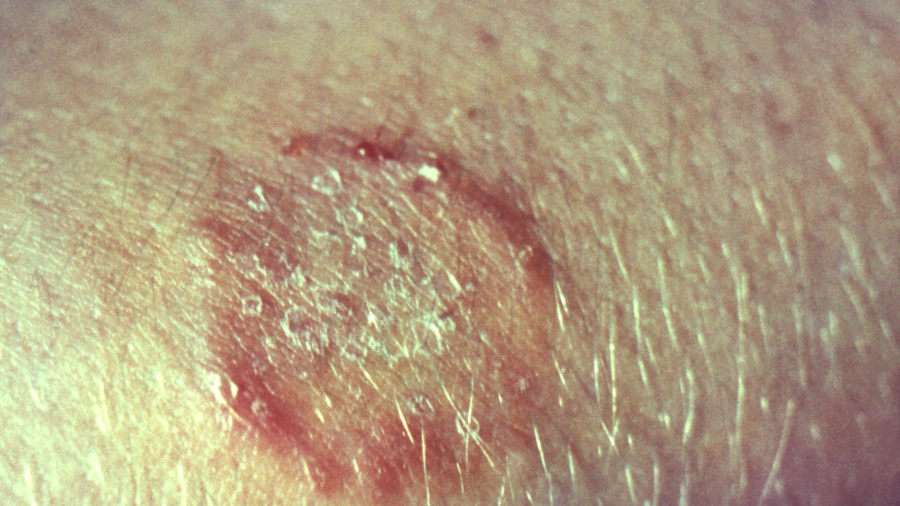At least two patients in New York City have been infected with antimicrobial-resistant ringworm, the first such cases in the United States with severe skin conditions.
Ringworm, also known as tinea, is a common, superficial infection of the skin, hair, or nails. It’s caused by a certain type of fungi that feed on keratin. It’s highly contagious and spreads easily through skin-to-skin contact with an infected person or animal.
The Centers for Disease Control and Prevention (CDC) on Thursday reported the two cases of ringworm.
According to the agency, a dermatologist on Feb. 28 notified public health officials about two patients who had “severe tinea that did not improve” when treated with an oral anti-fungal called terbinafine, a mainstay treatment.
Skin culture isolates from each patient were sent to the lab. By March, the isolates were identified as Trichophyton indotineae, a species of fungi that’s highly contagious.
Trichophyton indotineae
Infections involving this species have been reported throughout Asia, as well as in Europe and Canada. But this marks the first time T. indotineae infections have been reported in the United States.
During the past decade, an epidemic of “severe, antifungal-resistant” ringworm has emerged in South Asia due to T. indotineae spreading quickly, according to the CDC.
The epidemic “has likely been driven by misuse and overuse of topical antifungals and corticosteroids,” according to the CDC.
The infections caused by T. indotineae typically involve “widespread, inflamed, pruritic plaques”—or rashes with lesions—on the body, the thigh, the crease of the thigh, the pubic region, and/or the face.
Isolates of T. indotineae are often resistant to terbinafine.
The CDC said that given the two cases, doctors should consider T. indotineae as a diagnosis when first-line approaches don’t help resolve the tinea, and if the tinea is widespread.
Doctors suspecting this infection should notify state or local public health officials to help with testing. Patients who suspect they have this infection should let their doctors know.
Two Cases in New York City
The two patients, two females, have no links to each other, the CDC noted.
Patient A was 28 when she got a widespread rash in the summer of 2021. She had no recent history of traveling abroad.
After she gave birth to a baby in January 2022, she was diagnosed with ringworm and was given a course of oral terbinafine. But after two weeks, the condition didn’t resolve, so the doctor halted the terbinafine.
She was given a second course of treatment, this time using the medication itraconazole. After four weeks, her rash completely resolved. She is now being monitored in case the rash recurs.
“Patient A had no recent international travel history, suggesting potential local U.S. transmission of T. indotineae,” the CDC observed.
Patient B was 47 when she got a widespread rash in the summer of 2022, when she was traveling in Bangladesh.
She was treated there with topical creams, during which time several of her family members living there developed similar symptoms, she said.
When she returned to the United States, she visited an emergency department three times during autumn of 2022. On the first visit, she was prescribed hydrocortisone 2.5% ointment and diphenhydramine, which are allergy medications. On the second visit, she was given clotrimazole, which treats certain fungal skin conditions, and on the third visit, she was given terbinafine cream.
All treatments didn’t improve her rash, and by December 2022, dermatologists noted “widespread, discrete, scaly, annular, pruritic plaques” on her thighs and buttocks.
After a four-week course of oral terbinafine, her symptoms didn’t improve. Following that, she saw roughly 80 percent improvement with a four-week course of griseofulvin therapy.
Now that she is confirmed with T. indotineae infection, the doctors are considering treating her with itraconazole.
The woman’s son and husband who live in the same house have reported similar lesions on their skin and are “currently undergoing evaluation,” the CDC stated.
From The Epoch Times


